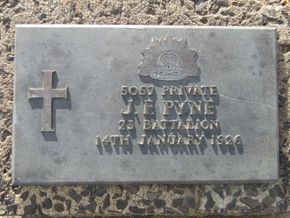PYNE, John Frederick
| Service Number: | 5075 |
|---|---|
| Enlisted: | 31 January 1916 |
| Last Rank: | Private |
| Last Unit: | 23rd Infantry Battalion |
| Born: | London, England, November 1879 |
| Home Town: | Melbourne, Melbourne, Victoria |
| Schooling: | Not yet discovered |
| Occupation: | Engineer |
| Died: | Died: fractured skull from attackby fellow patient , 16th GH Military Mental Asylum Mont Park, Victoria, Australia, 14 January 1926 |
| Cemetery: |
Fawkner Memorial Park Cemetery, Victoria |
| Memorials: |
World War 1 Service
| 31 Jan 1916: | Enlisted AIF WW1, Private, 5075, 23rd Infantry Battalion | |
|---|---|---|
| 19 Jul 1916: | Involvement Private, 5075, 23rd Infantry Battalion, --- :embarkation_roll: roll_number: '14' embarkation_place: Melbourne embarkation_ship: HMAT Armadale embarkation_ship_number: A26 public_note: '' | |
| 19 Jul 1916: | Embarked Private, 5075, 23rd Infantry Battalion, HMAT Armadale, Melbourne | |
| 6 Sep 1922: | Discharged AIF WW1, Private, 5075, 23rd Infantry Battalion, 3rd MD |
Help us honour John Frederick Pyne's service by contributing information, stories, and images so that they can be preserved for future generations.
Add my storyBiography contributed by Evan Evans
From How We Served
The final resting place for; -
5075 (5057) Private John Frederick Pyne
of London, England and Melbourne, Victoria, who had immigrated to Australia prior to the outbreak of hostilities in 1914.
John was employed as an engineer at the time of his enlistment for War Service on the 31st of January 1916, and was allocated to reinforcements for the 23rd Battalion 1st AIF, with which he embarked for England and further training with on the 19th of July.
Following his safe arrival in England on the 20th of September, and after a short time of further training he was sent over to France where he was disembarked on the 10th of November.
John was sent to the ‘Bull Ring’ at Etaples for his final phase of training before joining his Battalion in the trenches on the 2nd of December. Having only been in the line for just on a month, John was evacuated for medical care due to suffering from ‘trench fever’ and was returned to England as an invalid on the 20th of January 1917.
Here John would be treated in hospital, before he entered into convalescence after which he was deemed not fit for frontline service but instead retained in training camps at Salisbury Plains.
John’s fitness was revaluated at the start of October and he was relisted as fit for service and was embarked for France, where he again arrived on the 21st of October.
With the opening of the 3rd Battle of Ypres, John re-joined his Battalion in the trenches of Belgium on the 26th of October, and his service in the frontlines would be continuous until whilst serving in Northern France he was ‘Wounded in Action’ due to be gas poisoned on the 24th of July 1918.
After a short period of hospitalization at Le Havre John was returned to his Battalion for further service on the 29th of October. John would receive a short respite of Leave to England on the 9th of November and would be returned to France on the 29th of November.
Whilst he had been away from his Battalion the Armistice had been declared on the 11th of November marking the end of the First World War.
With the fighting now over John sought further service, and in March 1919 he was detached for service with the Australian War Graves Section.
Working in the monumental section, John’s service with War Graves would again be continuous, until whilst his section was employed in Belgium at Zonnebeke, where he suffered an accident on the 18th of February 1922, in which he received serious head injuries due to a fractured skull.
John’s health spiraled almost immediately, and he was to suffer a complete mental breakdown which would cause him to be hospitalized in England, until he was fit enough to be repatriated back to Australia.
Departing England on the 27th of May, John arrived back in Australia and after being disembarked in Melbourne he was admitted immediately into the 16th Australian General Hospital Military Mental Asylum at Mont Park on the 22nd of August 1922.
John would remain as a permanent inmate of the Asylum where he received on going treatment for delusional insanity until he was beaten to death by another military inmate, whilst he was resting in his bed on the 14th of January 1926.
Following his violent death at the Military Mental Asylum Private John Pyne, a gassed and invalided veteran of the ‘Great War’, and who had then worked continuously with the Australian War Graves Section following the end of hostilities, was formally, laid to rest within Fawkner Memorial Park Cemetery, Victoria.










